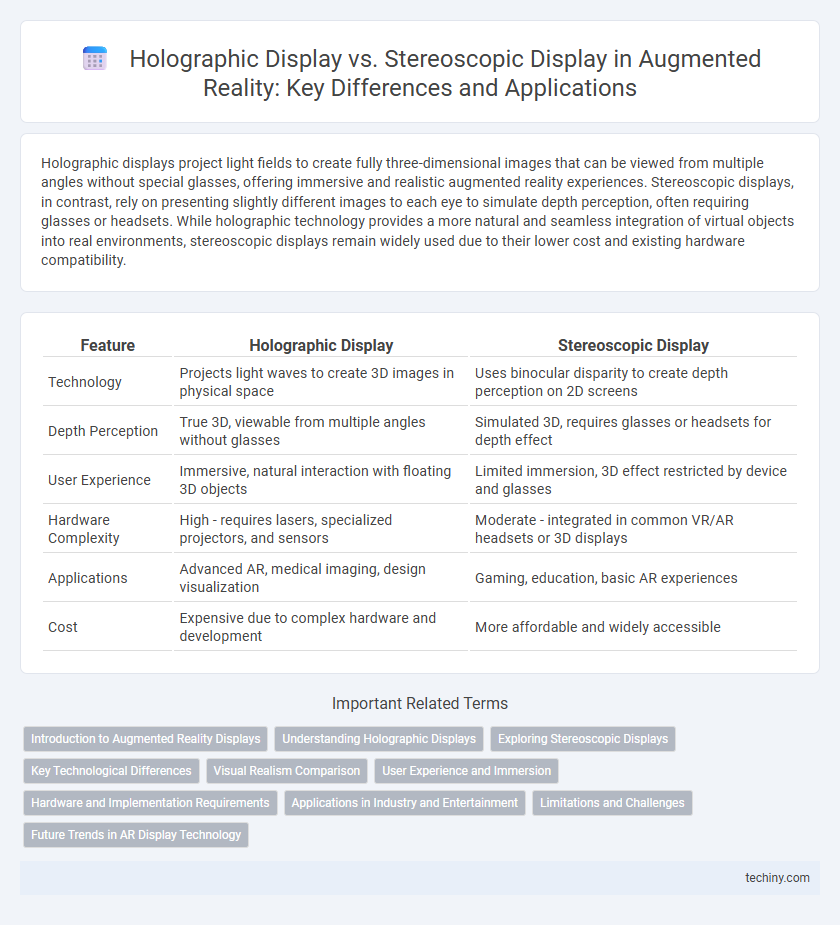Holographic displays project light fields to create fully three-dimensional images that can be viewed from multiple angles without special glasses, offering immersive and realistic augmented reality experiences. Stereoscopic displays, in contrast, rely on presenting slightly different images to each eye to simulate depth perception, often requiring glasses or headsets. While holographic technology provides a more natural and seamless integration of virtual objects into real environments, stereoscopic displays remain widely used due to their lower cost and existing hardware compatibility.
Table of Comparison
| Feature | Holographic Display | Stereoscopic Display |
|---|---|---|
| Technology | Projects light waves to create 3D images in physical space | Uses binocular disparity to create depth perception on 2D screens |
| Depth Perception | True 3D, viewable from multiple angles without glasses | Simulated 3D, requires glasses or headsets for depth effect |
| User Experience | Immersive, natural interaction with floating 3D objects | Limited immersion, 3D effect restricted by device and glasses |
| Hardware Complexity | High - requires lasers, specialized projectors, and sensors | Moderate - integrated in common VR/AR headsets or 3D displays |
| Applications | Advanced AR, medical imaging, design visualization | Gaming, education, basic AR experiences |
| Cost | Expensive due to complex hardware and development | More affordable and widely accessible |
Introduction to Augmented Reality Displays
Holographic displays create 3D images by reconstructing light waves, offering depth perception without special glasses, making them a key innovation in augmented reality (AR) for immersive visualization. Stereoscopic displays present two offset images to each eye, simulating depth through binocular disparity but often require glasses and have limited viewing angles. Understanding these AR display technologies is essential for developing applications in fields such as medical imaging, gaming, and remote collaboration.
Understanding Holographic Displays
Holographic displays create three-dimensional images by recording and reconstructing light wavefronts, enabling realistic depth perception and parallax without the need for special glasses. Unlike stereoscopic displays that rely on two slightly different images to create a perception of depth, holographic displays project light fields that allow viewers to see true 3D content from multiple angles. This technology enhances augmented reality experiences by providing more natural and immersive visuals, critical for applications in medical imaging, design visualization, and remote collaboration.
Exploring Stereoscopic Displays
Stereoscopic displays create depth perception by presenting slightly different images to each eye, enhancing immersive experiences in augmented reality applications. These displays rely on binocular disparity to simulate three-dimensional visuals, improving user interaction and spatial awareness. Compared to holographic displays, stereoscopic systems are more accessible and cost-effective, making them popular for AR devices and applications.
Key Technological Differences
Holographic displays project light fields to create three-dimensional images that appear to float in space, offering true depth perception and parallax without the need for special glasses. Stereoscopic displays rely on binocular disparity by presenting two slightly different images to each eye, requiring eyewear to simulate depth and often causing viewer fatigue. The core technological difference lies in holography's wavefront reconstruction versus stereoscopy's image separation, impacting visual realism and user comfort in augmented reality applications.
Visual Realism Comparison
Holographic displays project light fields that reconstruct wavefronts, enabling true depth perception and natural focus cues, resulting in superior visual realism compared to stereoscopic displays. Stereoscopic displays create the illusion of depth by presenting two slightly different images to each eye, but can cause eye strain and lack accommodation cues essential for realistic perception. The ability of holographic displays to support dynamic parallax and accurate focus adjustment significantly enhances immersion in augmented reality environments.
User Experience and Immersion
Holographic displays project light fields that enable users to perceive depth and parallax naturally, creating a highly immersive experience without the need for headgear. Stereoscopic displays provide depth perception by delivering separate images to each eye but often cause eye strain and limited viewing angles, reducing overall user comfort. The holographic approach significantly enhances user engagement and realism in augmented reality applications compared to stereoscopic systems.
Hardware and Implementation Requirements
Holographic displays require complex wavefront manipulation hardware, including spatial light modulators and coherent light sources, to create true 3D images that can be viewed from multiple angles without glasses. In contrast, stereoscopic displays rely on simpler dual-image projection systems, often employing polarizing filters or shutter glasses, to simulate depth by delivering separate images to each eye. The implementation of holographic displays demands advanced computational power and precise calibration, whereas stereoscopic systems are more straightforward and cost-effective but offer limited viewing angles and depth perception.
Applications in Industry and Entertainment
Holographic displays create fully three-dimensional images that can be viewed from multiple angles without special glasses, making them ideal for industrial applications like design prototyping, medical imaging, and complex data visualization. Stereoscopic displays rely on the perception of depth through two slightly different images, requiring glasses to generate 3D effects commonly used in entertainment sectors such as gaming and virtual reality experiences. The industrial use of holographic displays enhances collaborative engineering and realistic training simulations, while stereoscopic displays dominate immersive entertainment due to their cost-effectiveness and well-established technology.
Limitations and Challenges
Holographic displays face significant challenges including high computational requirements and complex optics that limit their widespread adoption. Stereoscopic displays often suffer from viewer discomfort and limited depth perception due to fixed focal planes and crosstalk effects. Both technologies require advancements in hardware efficiency and visual fidelity to overcome current limitations in augmented reality applications.
Future Trends in AR Display Technology
Holographic displays offer true 3D visualization by projecting light fields, enabling more immersive and natural augmented reality experiences compared to stereoscopic displays, which rely on dual images to create depth perception. Future trends indicate advancements in holographic display resolution, field of view, and real-time rendering capabilities will drive widespread adoption in AR hardware. The integration of AI-powered optimization and lightweight, energy-efficient components will further enhance the practicality and realism of holographic AR displays, surpassing stereoscopic alternatives.
Holographic Display vs Stereoscopic Display Infographic

 techiny.com
techiny.com